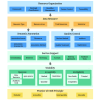Toward Better Semantic Interoperability of Data Element Repositories in Medicine: Analysis Study
- PMID: 39348178
- PMCID: PMC11474123
- DOI: 10.2196/60293
Toward Better Semantic Interoperability of Data Element Repositories in Medicine: Analysis Study
Abstract
Background: Data element repositories facilitate high-quality medical data sharing by standardizing data and enhancing semantic interoperability. However, the application of repositories is confined to specific projects and institutions.
Objective: This study aims to explore potential issues and promote broader application of data element repositories within the medical field by evaluating and analyzing typical repositories.
Methods: Following the inclusion of 5 data element repositories through a literature review, a novel analysis framework consisting of 7 dimensions and 36 secondary indicators was constructed and used for evaluation and analysis.
Results: The study's results delineate the unique characteristics of different repositories and uncover specific issues in their construction. These issues include the absence of data reuse protocols and insufficient information regarding the application scenarios and efficacy of data elements. The repositories fully comply with only 45% (9/20) of the subprinciples for Findable and Reusable in the FAIR principle, while achieving a 90% (19/20 subprinciples) compliance rate for Accessible and 67% (10/15 subprinciples) for Interoperable.
Conclusions: The recommendations proposed in this study address the issues to improve the construction and application of repositories, offering valuable insights to data managers, computer experts, and other pertinent stakeholders.
Keywords: FAIR; ISO/IEC 11179; data element repository; metadata; semantic interoperability.
©Zhengyong Hu, Anran Wang, Yifan Duan, Jiayin Zhou, Wanfei Hu, Sizhu Wu. Originally published in JMIR Medical Informatics (https://medinform.jmir.org), 30.09.2024.
Conflict of interest statement
Conflicts of Interest: None declared.
Figures




Similar articles
-
An ecosystem for producing and sharing metadata within the web of FAIR Data.Gigascience. 2025 Jan 6;14:giae111. doi: 10.1093/gigascience/giae111. Gigascience. 2025. PMID: 39775840 Free PMC article.
-
A Data Transformation Methodology to Create Findable, Accessible, Interoperable, and Reusable Health Data: Software Design, Development, and Evaluation Study.J Med Internet Res. 2023 Mar 8;25:e42822. doi: 10.2196/42822. J Med Internet Res. 2023. PMID: 36884270 Free PMC article.
-
Pragmatic MDR: a metadata repository with bottom-up standardization of medical metadata through reuse.BMC Med Inform Decis Mak. 2021 May 17;21(1):160. doi: 10.1186/s12911-021-01524-8. BMC Med Inform Decis Mak. 2021. PMID: 34001121 Free PMC article.
-
Evaluation of repositories for sharing individual-participant data from clinical studies.Trials. 2019 Mar 15;20(1):169. doi: 10.1186/s13063-019-3253-3. Trials. 2019. PMID: 30876434 Free PMC article. Review.
-
FAIR, ethical, and coordinated data sharing for COVID-19 response: a scoping review and cross-sectional survey of COVID-19 data sharing platforms and registries.Lancet Digit Health. 2023 Oct;5(10):e712-e736. doi: 10.1016/S2589-7500(23)00129-2. Lancet Digit Health. 2023. PMID: 37775189 Free PMC article.
References
-
- Schofield PN, Bubela T, Weaver T, Portilla L, Brown SD, Hancock JM, Einhorn D, Tocchini-Valentini G, Hrabe de Angelis M, Rosenthal N, CASIMIR Rome Meeting participants Post-publication sharing of data and tools. Nature. 2009 Sep 10;461(7261):171–3. doi: 10.1038/461171a. https://europepmc.org/abstract/MED/19741686 461171a - DOI - PMC - PubMed
-
- Dugas M, Hegselmann S, Riepenhausen S, Neuhaus P, Greulich L, Meidt A, Varghese J. Compatible data models at design stage of medical information systems: leveraging related data elements from the MDM portal. Stud Health Technol Inform. 2019 Aug 21;264:113–117. doi: 10.3233/SHTI190194.SHTI190194 - DOI - PubMed
-
- Courtot M, Cherubin L, Faulconbridge A, Vaughan D, Green M, Richardson D, Harrison P, Whetzel PL, Parkinson H, Burdett T. BioSamples database: an updated sample metadata hub. Nucleic Acids Res. 2019 Jan 08;47(D1):D1172–D1178. doi: 10.1093/nar/gky1061. https://europepmc.org/abstract/MED/30407529 5165182 - DOI - PMC - PubMed
-
- Vempati Ud, Chung C, Mader C, Koleti A, Datar N, Vidović D, Wrobel D, Erickson S, Muhlich Jl, Berriz G, Benes Ch, Subramanian A, Pillai A, Shamu Ce, Schürer Stephan C. Metadata standard and data exchange specifications to describe, model, and integrate complex and diverse high-throughput screening data from the Library of Integrated Network-based Cellular Signatures (LINCS) J Biomol Screen. 2014 Jun;19(5):803–816. doi: 10.1177/1087057114522514. https://europepmc.org/abstract/MED/24518066 1087057114522514 - DOI - PMC - PubMed
MeSH terms
LinkOut - more resources
Full Text Sources

